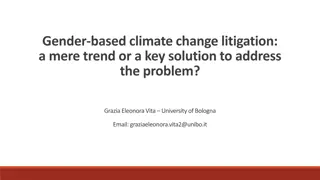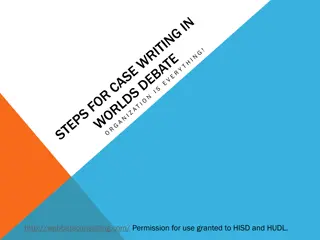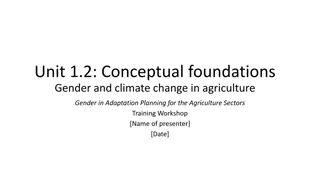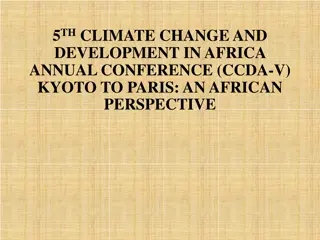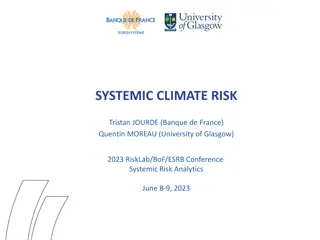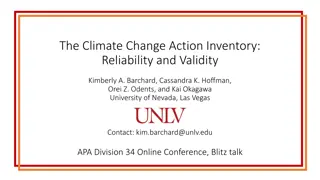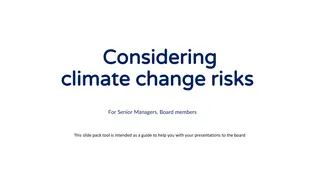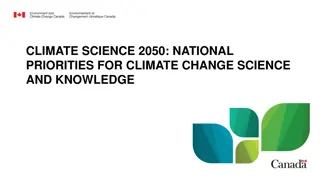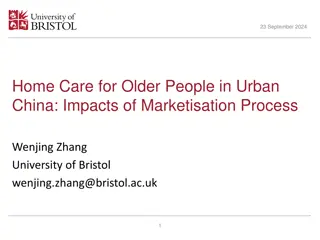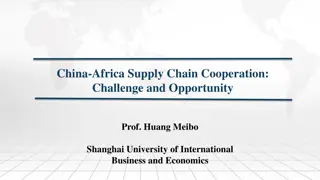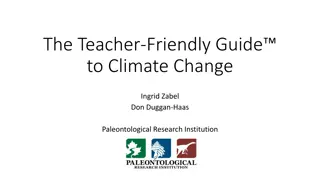Evaluating the Impact of Communism on Climate Change in China
This study analyzes the effects of political ideology on climate change in China, specifically focusing on the difference in extreme temperatures from 1954 to 2010. Results show a significant decrease in extreme temperatures in earlier years followed by an increase from 2000 onwards, particularly during summer months. The research also highlights the influence of environmental transparency on the frequency of extreme temperatures. Data from historical and modern sources, along with a detailed methodology, support the findings.
Download Presentation

Please find below an Image/Link to download the presentation.
The content on the website is provided AS IS for your information and personal use only. It may not be sold, licensed, or shared on other websites without obtaining consent from the author.If you encounter any issues during the download, it is possible that the publisher has removed the file from their server.
You are allowed to download the files provided on this website for personal or commercial use, subject to the condition that they are used lawfully. All files are the property of their respective owners.
The content on the website is provided AS IS for your information and personal use only. It may not be sold, licensed, or shared on other websites without obtaining consent from the author.
E N D
Presentation Transcript
Climate change in China: Communism is cooler I.P.L. Png Junhong Chu Yehning Chen
China, July and August daily max temperature: 1951-2010 vis-a-vis 1929-44
Findings Frequency of extreme temperatures ( 35 C) decreased sharply from 1954 increased from 2000 onward Effect limited to summer months (June-August) Effect more pronounced At stations where average summer temperature in 1929-44 relatively higher In provincial capitals Robust to Control for aerosol effect (sunshine hours) Sample, specification, method
Findings, contd Increased frequency of extreme temperatures from 2000 onward More pronounced in stations with higher score for environmental transparency
Outline Data Method Results Explanations Hot weather policy Discussion
Data sources: Historical China, 1912-49 , , Monthly Meteorological Bulletin, Academia Sinica, National Research Institute of Meteorology, Pei-Chi-Ko, Nanking, China, 1928-37 , , North China Monthly Meteorological Bulletin, North China Meteorological Department, Japanese Army, 1939-44 Other observatories and agencies Provinces: Fujian, Hunan, Jiangsu, Manchuria, Sichuan Cities: Dalian, Qingdao, Society of Jesus Kiangnan Mission, Shanghai
Data sources: Modern China, 1951-2010 China Meteorological Administration (CMA): Surface weather database, version 3.0 -- up to 824 stations Minimum and maximum temperature Sunshine Global Historical Climatology Network (GHCN) -- up to 199 stations Minimum and maximum temperature
Data: Matching China stations Matching criteria Location Longitude and latitude: Distance < 10 kilometres Difference in elevation < 100 metres At least 5 years of records in 1929-1944 (with at least 6 months per year) At least 19 stations in each year Matched data-set 65 stations, 1929-44 and 1951-2010 1,539,393 observations of daily max and min temperature 1,318,497 observations of daily sunshine duration
Data sources: Non-mainland/foreign, 1929- 2010 Hong Kong Observatory One station Japan Meteorological Agency 6 stations in southwest Korea Meteorological Administration 9 stations in west Taiwan: Central Weather Bureau 5 stations in west Matched data-set 21 stations, 1929-2010 590,083 observations of daily max and min temperature
Data Quality Conventional checks Compared across sources 1954 compilation of monthly averages ( / ) Multiple original sources Inhomogeneities Movement of stations Changes in technology, standards, and procedures
Outline Data Methods Results Explanations Hot weather policy Discussion
Empirical strategy Difference in difference 1929-1944: summer temperatures more extreme in China than foreign 1954-2000: summer temperatures less extreme in China than foreign Benchmark for extreme: Probability of daily maximum temperature 35 C
Method: Multiple regression Unit of analysis: Station + date More robust to errors in data than annual or monthly model More precise estimate -- annual/monthly average of daily extremes understates the effects Dependent variable: Daily maximum temperature for each station Probability of daily maximum temperature benchmark (35 C) -- to investigate the frequency of extreme temperatures
National model Dependent variable Daily maximum temperature Probability of daily maximum temperature benchmark (35 C) Explanatory variables -- fixed effects Stations (regional differences) Years (average of dependent variable for year) Months (seasonal differences) China x years (average increment in dependent variable for China relative to foreign countries in each year)
Station-specific model Dependent variable Daily maximum temperature Probability of daily maximum temperature benchmark (35 C) Explanatory variables: Fixed effects Station-year: Urban heat island effect, movement of station, change in meteorological standard, change in recording procedure or personnel Station-month: Differences in seasonality Station x Post-1954 (including foreign stations) [Standard errors clustered by station]
Daily max, Nanjing, July 1934 and 1980
Daily max, Nanjing, July and Aug 1934
Outline Data Method Results National model Station-specific model Explanations Hot weather policy Discussion
National model: Daily max temperature: Year fixed effects (annual average)
National model: Prob (daily max temp 35C): Year fixed effects (annual average) China and foreign series normalized to 2010
National model: Daily max temperature, Jun- Aug: Year fixed effects (annual average)
National model: Prob (daily max temp 35C), Jun-Aug: Year fixed effects (annual average) Structural break 1954 Structural break 2001
Incremental prob of daily max temp >= 35C in 1951- 2010 relative to 1929-44 in China (relative to foreign)
Prob of daily max temp 35oC in July, 1954- 2010 vis-a-vis 1929-1944
Prob of daily max temp 35oC in August, 1954-2010 vis-a-vis 1929-1944
Robustness checks Sample Distance 5km, number of years 7 Homogeneous: 36 China + 21 foreign stations, all years, 1951-2010 Measurement Pre-1950 observations clustered at .0 and .5: Alternative benchmark: Probability of daily maximum temperature 34.9oC Specification: Week fixed effects Estimation method Logit Probit
Outline Data Method Results Explanations Aerosol effects Evolution of climate: Coastal/inland Urbanization Technology, standards, and procedures Hot weather policy Discussion
Aerosol effects Atmospheric aerosols Directly scatter and absorb solar radiation Indirectly provide nuclei for condensation of clouds or formation of ice Sources of aerosols Cloud Water vapour Humidity Dust Emissions -- increase with China s economic growth Overall measure: daily sunshine hours Limited data => smaller sample
Prob of daily max temp 35oC: Including sunshine hours
Prob of daily max temp 35oC: Sunshine sample without sunshine covariate
Evolution of climate: Inland/coastal Permanent regional differences -- inland climate more extreme Absorbed by station fixed effects Conjecture -- time-varying regional differences: Perhaps climate of inland China evolved differently from coastal areas (China, Korea, Hong Kong) and offshore islands (Japan, Taiwan)
Urbanization Urbanization affects temperature Building materials absorb and release radiation Surface materials Vegetation Surface moisture Southeast China (Zhou et al. PNAS 2004): Warming trend in minimum temperature (+0.116oC per decade) in winter 10x larger than effect on maximum temperature 21% of overall warming trend in minimum temperature Cooling trend in maximum temperature (-0.016oC per decade) in winter
Urbanization Urban heat island effect -- strongest effect in winter Our results most pronounced in summer Station-level model: Accounted for by fixed effects for station-year and fixed effects for station-month
Technology, standards, and procedures Difficult to explain observed national effect on summer extreme temperatures through changes in technology, standards, and procedures General -- change should uniformly affect all recorded temperatures, not asymmetrically affect higher temperatures Movement of stations -- specific to stations, not nation-wide
Technology, standards, and procedures (Kaiser et al. 1993) But attenuation of extreme temperatures did not reverse around 1960/61 Temperature Instrument height 1950-53: 1.5 metres 1954-60: 2 metres 1961-onward: 1.5 metres Observation time up to 1950: 2000 hrs Beijing time 1951-53: 2000 hrs Local Standard Time 1954-60: 2000 hrs Local Mean Solar Time 1961-onward: 2000 hrs Beijing time Sunshine up to 1953: Jordan Photographic Sunshine Recorder
Outline Data Method Results Explanations Hot weather policy Discussion
Government policy 1954: Iron and Steel Bureau: Report on hot weather measures Temperatures in workshop must not exceed 30oC 1956: State Council: Notice to accelerate implementation of summer hot weather measures Temperatures in some areas of Southern China have exceeded 100-year records In extremely hot weather, if remedial measures not possible, consider temporary work suspension No overtime work during hot weather
Government policy 1960: Ministry of Health, Ministry of Labor, and National Federation of Trade Unions: Interim Regulation on Hot Weather Work Provincial governments progressively introduced detailed regulations on hot weather work 1963: Guangzhou 1994: Shenzhen 2005: Hunan, Jiangsu 2007: Chongqing, Hubei, Beijing
Government policy 2007: Additional measures 2012: State Administration of Work Safety, Ministry of Health, Ministry of Human Resources and Social Security, and All China Federation of Trade Unions: Final Regulation No. 89 of 2012
Final Regulation, No. 89 of 2012 , , , 2012 89 : 1. 40 2. 37 40 6 3 3. 35 37
Incentives of local government officials : The sky is high and the emperor is far away Pre-1978 reform Local officials required to meet central planning targets Post-1978 reform Government depends on industrial enterprises for revenues and other support Local officials evaluated by economic performance of their territory (Li and Zhou 2005)
Weather reporting 1956: Temperatures in some areas of Southern China have exceeded 100-year records (State Council) All stations: Jun-Aug temperatures lower in 1956 than 1929-44 Conjecture: Re-writing of historical weather statistics 2010: Li Kai-le, ex senior technical officer, Guangdong Province Meteorological Office: Some officials worry about the cost and disruption of warnings, and ask for a more conservative forecast (Nanfang.com, 2010)
Compliance with hot weather regulations 1954: some enterprises did not truthfully report heat stroke incidents and workshop temperature (Iron and Steel) 1956: some enterprises did not prepare measures for hot weather work in summer (State Council) 1956: Wenzhou Steel Factory concealed industrial accidents, reported 8 instead of 21 in August ( Factory manager Zheng Kezhong did not respect worker safety )
Prob of daily max temp 35oC, Jun-Aug: Provincial capitals vis-a-vis other stations





